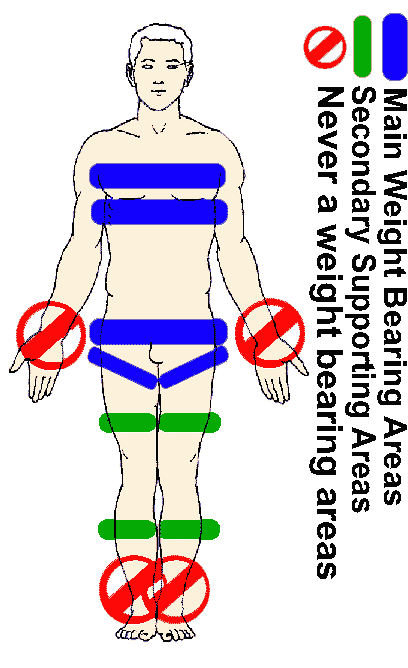Suspensions should only be done by Advanced Users!
You should be very experienced with static tying, and have a good background and experience in medical information needed to do this. I highly suggest learning hands -
on from someone who had experience doing this type of activity!
Technically suspension is not very hard to do, it can be a deadly actively is done wrong.
The real key to suspension is know what not to do, what to look out for, and how to prevent accidents from happening!
Weight Bearing Points
 Main weight Support Area
Main weight Support Area
For any kind of bondage where the rope will be supporting body weight for static, semi-suspension, or full suspension, there is only 3 areas of the body that can
support weight!
-
The Chest / Upper back:
Below and above the chest for face down angled or horizontal semi/suspension and armpit areas upper back for face up semi/suspension.
-
The Waist:
for face up or down semi/suspension.
-
Upper Thighs:
For mountain climbing harness type support in the crotch area.
Secondary weight support Area
Some areas can be used for secondary, if a majority (90% or greater) of the body weight is supports in the Main areas. These secondary areas are the lower thighs and
calves. Sometime the upper and lower arms can also be used, but generally the best areas to do so.
Never:
use the wrist or ankles as load bearing points! These body parts have no ability to support body weight, and serious injuries can be causes!
Rope bearing loads.
(Important safety info regarding rope strength)
Now when doing static bondage (i.e. non-semi/suspension), the type of rope you use, is not very important, outside that is feel good and works. With semi/suspension,
the type of rope you use is VERY IMPORTANT to what you are doing. You have to remember, the rope is keeping the people from falling, it is literally their life line!
First of, NEVER use Cotton rope for suspension work.
Second, when dealing with weight baring bondage, there is two things you have to think about,
weight load
of the rope, and
tensile strength
of the rope. The weight load would be how much the person weights/how much the rope is made to hold. The tensile strength is the amount of weight the rope can hold
under stress, free fall, or shock. For an example, MFP 3/8" is approx. rated at 270pds weight load / 1600pds tensile strength. Hemp at 3/8" is about 1200
weight load / 2000pds tensile strength.
Determining amount weight need to be supported a victim.
Now when dealing with weight bearing bondage, here is a simple calculation to do ... Weight load X 10 = tensile support needed. So dealing with suspension of a person,
it would be ...
Persons weight X 10 = tensile strength needed to be safe.
I.e. if a 200pd person is being suspended the calculation would be 200pds X 10 = minimal 2000 pds of tensile strength needed to be safe.
Determining the amount of wet rope can support
First off, you need to find the amount the makers of the rope your using, the weight load, and tensile strength of the rope you are using. You can usually get this
info from the package, or website of the makers of the rope.
TIP:
Now when I am doing suspension, I tend to be overly safe, but you can never be too safe. Always Over estimate the weight of you victim, and under estimate the strength
your rope!
Now with shibari style bondage, you double up the rope by folding it in half and tie it off with square knots. This should make each rope act as 2 pieces. Because
there is no tension on the fold if done right. I use 2 pieces of hemp for the main supports (usually the chest harness, and waste harness.), and then at least 2
more supports made of jute. Sometimes more. So using the calculating the support and tensile strength of this set up would be
Example Usage:
Hemp: 2x2x1200 = 4800pd weight load, jute 2x2x800 = 3200pd. 4800pd+3200pd = 8000pd weight load. The tensile strength is hemp 2x2x2000=8000, jute 2x2x1600= 6400 = 8000 =
14400pd of tensile strength.
So a 200 pd person = 200 pd weight laod / 2000pd tensile strength needed to be minimally safe. And with 8000 pd weight load / 14400 pds tensile strength of rope I have
described above, my amount are way higher then needed. Thus a very good safety load for doing suspension.
|



